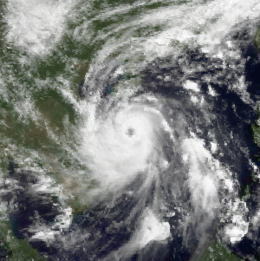Tropical Storm Cecil
| Severe tropical storm (JMA scale) | |
|---|---|
| Category 1 typhoon (SSHWS) | |
 Tropical Storm Cecil approaching central Vietnam on May 24 | |
| Formed | May 22, 1989 |
| Dissipated | May 26, 1989 |
| Highest winds | 10-minute sustained: 110 km/h (70 mph) 1-minute sustained: 140 km/h (85 mph) |
| Lowest pressure | 975 hPa (mbar); 28.79 inHg |
| Fatalities | 751 total |
| Damage | $71.7 million (1989 USD) |
| Areas affected | Vietnam, Laos, Thailand |
| Part of the 1989 Pacific typhoon season | |
Severe Tropical Storm Cecil in May of 1989 caused devastating floods in central
In Vietnam, heavy rains accompanied the storm, amounting to over 510 mm (20 in) in some areas, triggered catastrophic and deadly flooding. Widespread structural and agricultural losses took place in addition to the significant loss of life, with damage estimated at
Meteorological history

Tropical storm (39–73 mph, 63–118 km/h)
Category 1 (74–95 mph, 119–153 km/h)
Category 2 (96–110 mph, 154–177 km/h)
Category 3 (111–129 mph, 178–208 km/h)
Category 4 (130–156 mph, 209–251 km/h)
Category 5 (≥157 mph, ≥252 km/h)
Unknown
On May 20, following Typhoon Brenda's passage through the South China Sea, a monsoon trough extending from the area into the Bay of Bengal received enhanced low-level southwesterly flow. An environment of weak wind shear in the wake of the typhoon allowed a new area of low pressure to form within the southwesterly flow on May 21. With convection becoming persistent and the system's overall presentation more organized by May 22, the JTWC issued a Tropical Cyclone Formation Alert at 0300 UTC.[2] Around this time, the Japan Meteorological Agency (JMA) classified the system as a tropical depression.[3][nb 2] Later that day, convection wrapped entirely around the center of circulation; this structural improvement, combined with nearby surface observations, prompted the JTWC to designate the system as Tropical Storm Cecil.[2]
Initially, Cecil was forecast to maintain a northward track into a weakness in a
Impact and aftermath
In addition to the considerable losses that took place in Vietnam, Cecil also produced heavy rains in Laos and northeastern Thailand, resulting in flooding and crop damage.[2]
Vietnam
Tropical Storm Cecil was regarded as the worst storm to strike Vietnam in 50 years.
In the wake of the storm, Vietnamese soldiers were deployed to rescue survivors. Local police forces were also stepped up to prevent looting.
See also
- 1989 Pacific typhoon season
- Other tropical cyclones that impacted Vietnam in 1989:
Notes
- ^ The Joint Typhoon Warning Center is a joint United States Navy – United States Air Force task force that issues tropical cyclone warnings for the western Pacific Ocean and other regions.[1]
- Regional Specialized Meteorological Center for the western Pacific Ocean.[4]
References
- ^ "Joint Typhoon Warning Center Mission Statement". Joint Typhoon Warning Center. United States Navy. 2011. Archived from the original on July 26, 2007. Retrieved March 2, 2013.
- ^ a b c d Cpt. John D. Pickle (1990). "1989 Annual Tropical Cyclone Report: Typhoon Cecil (04W)" (PDF). Joint Typhoon Warning Center. United States Navy. pp. 50–51. Archived from the original (PDF) on February 6, 2020. Retrieved March 2, 2013.
- ^ .TXT) on December 5, 2014. Retrieved March 2, 2013.
- ^ "Annual Report on Activities of the RSMC Tokyo – Typhoon Center 2000" (PDF). Japan Meteorological Agency. February 2001. p. 3. Retrieved March 2, 2013.
- .TXT). Joint Typhoon Warning Center. United States Navy. 1990. Retrieved March 2, 2013.
- ^ a b "Worst Natural Disaster". Bangkok, Thailand: New Straits Times. Reuters. June 1, 1989. p. 15F. Retrieved March 2, 2013.
- ^ a b "Tropical storm". United Press International. Bangkok, Thailand: Ellensburg Daily Record. May 29, 1989. p. 12. Retrieved March 2, 2013.
- ^ a b c d "Viet Nam Cyclone Cecil May 1989 UNDRO Situation Reports 1-3". United Nations Department of Humanitarian Affairs. ReliefWeb. June 16, 1989. Retrieved March 2, 2013.
- ^ "Typhoon kills 140 in Vietnam". Hanoi, Vietnam: Xinhua General News. May 31, 1989. – via LexisNexis (subscription required)
- ^ a b "Central official tours province affected by typhoon". British Broadcasting Corporation. June 7, 1989. – via LexisNexis (subscription required)
- ^ "Typhoon and torrential rains hit Vietnam". British Broadcasting Corporation. May 31, 1989. – via LexisNexis (subscription required)
- ^ "Country Disaster Response Handbook: Vietnam" (PDF). Center for Excellence in Disaster Management & Humanitarian Assistance. October 2012. p. 9. Archived from the original (PDF) on October 8, 2013. Retrieved March 2, 2013.
External links
- Japan Meteorological Agency
- Joint Typhoon Warning Center Archived August 9, 2015, at the Wayback Machine

